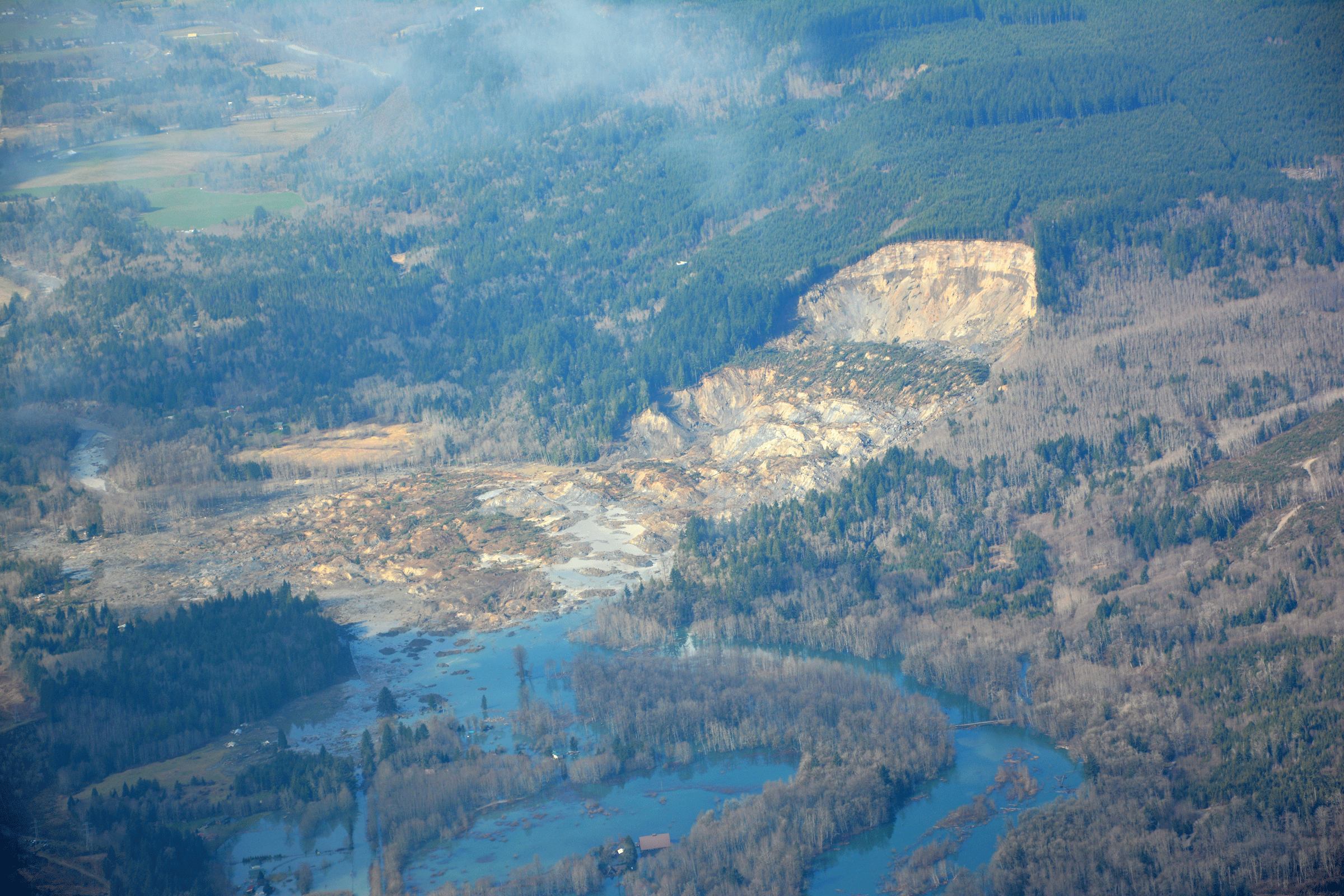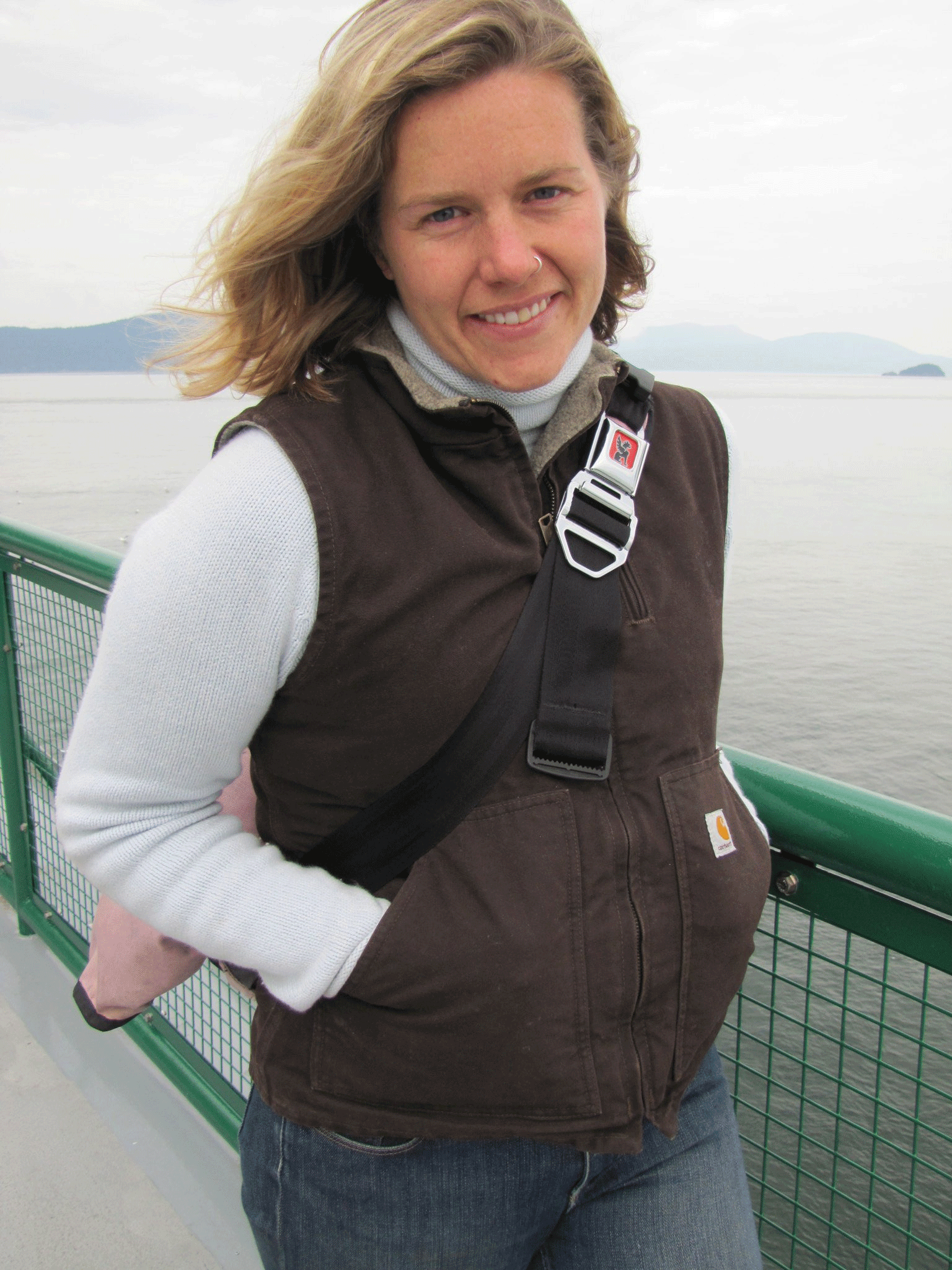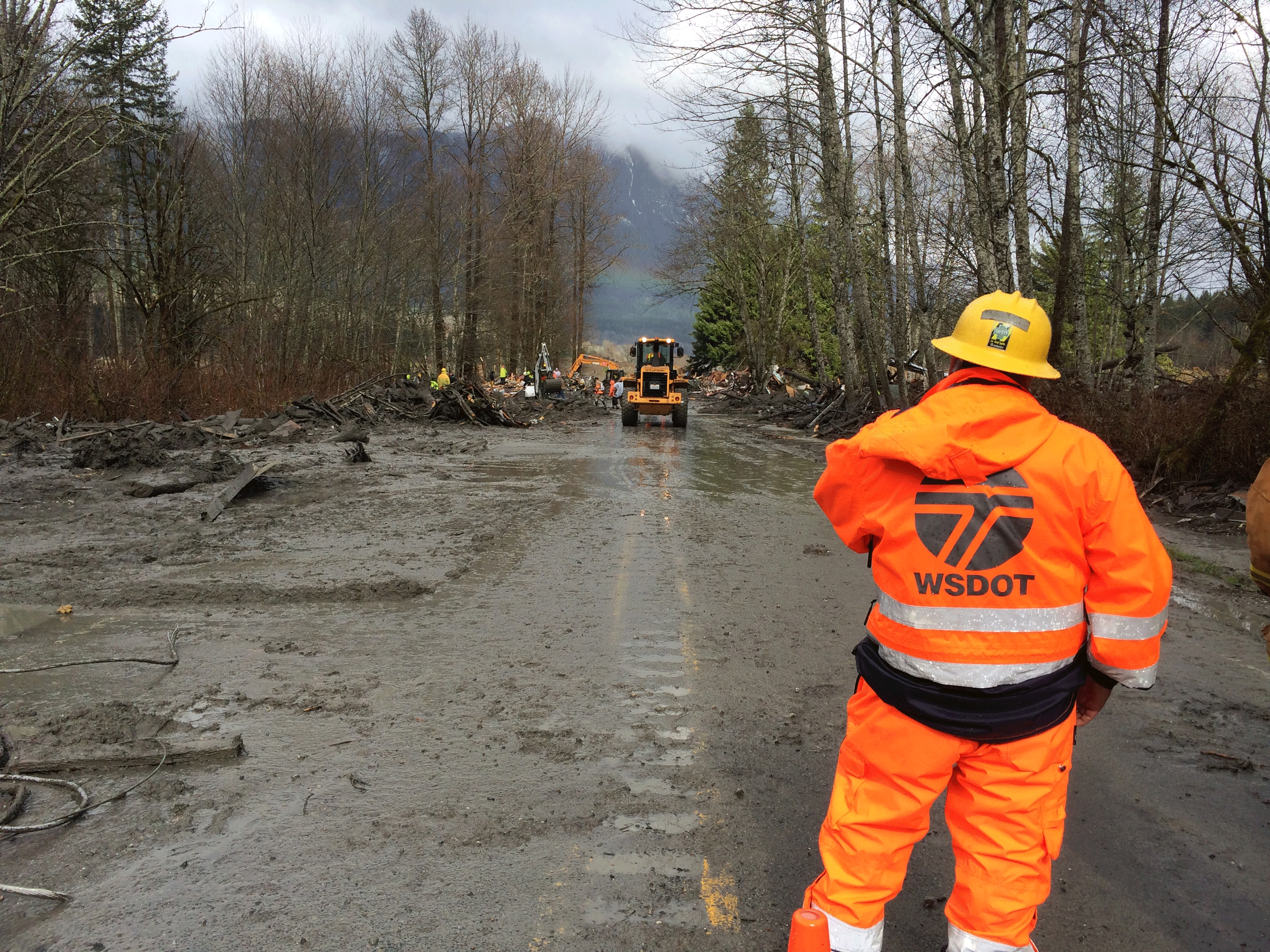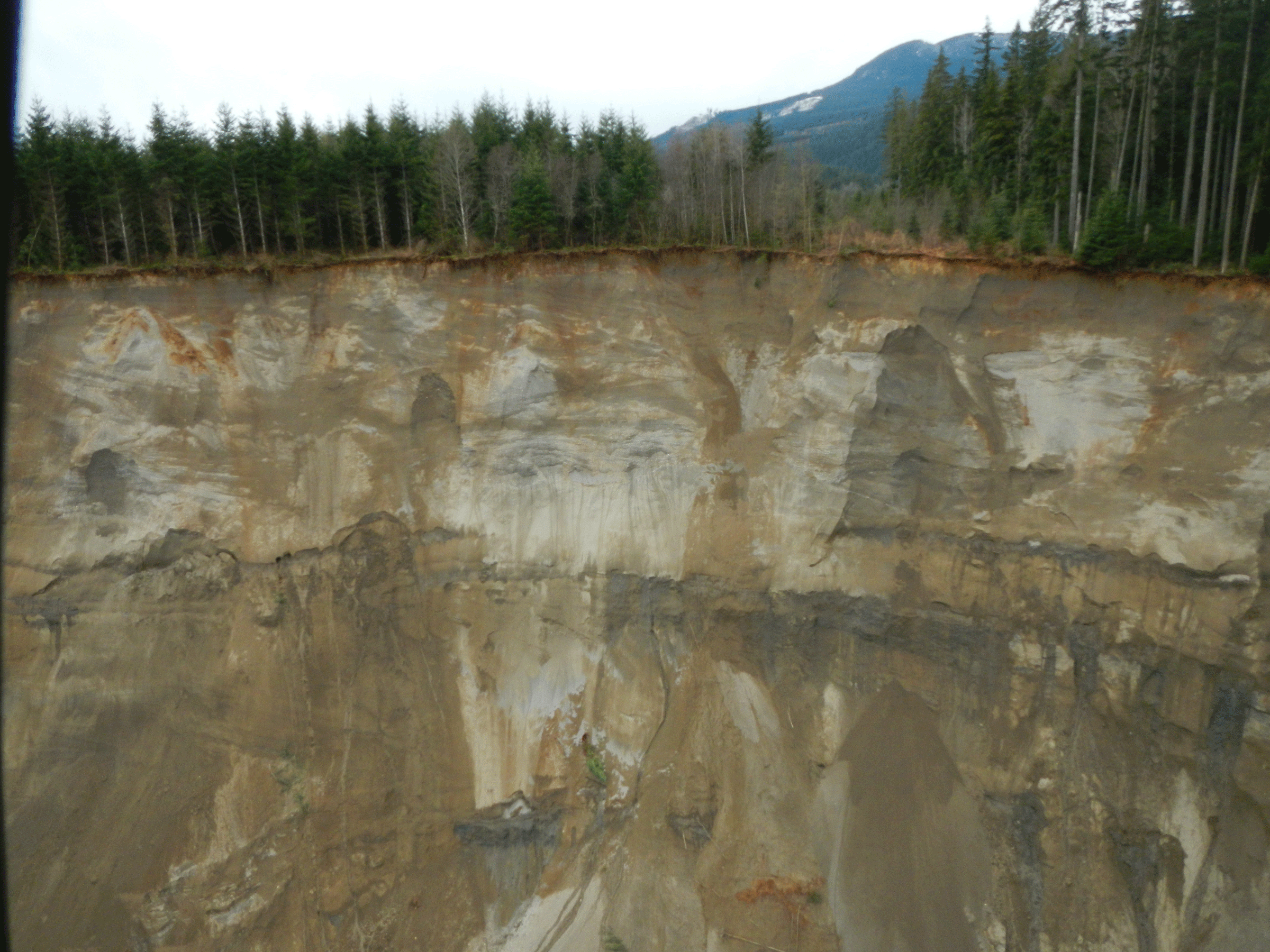Washington State Landslide -- Living with Risk
Air Date: Week of April 4, 2014

An aerial view of the Oso, Washington landslide (photo: Washington State Department on Transportation)
The danger from landslides was well-known in Washington state, but that didn’t stop local officials from letting people build in the danger zone. Ashley Ahearn reports on the geology and planning from Seattle and discusses why people live in harm’s way with host, Steve Curwood.
Transcript
CURWOOD: It's Living on Earth, I'm Steve Curwood. President Obama has declared the devastating March 22 landslide in the Cascades a major disaster, making more programs and recovery aid available to Washington State. Some 50 people are dead or missing, most of them from a small community tucked into a bend in the Stillaguamish River. Ashley Ahearn of the public radio collaborative Earthfix has been covering the disaster since it happened. She reports that the danger of landslides was known, but that didn't stop local officials from allowing homes to be built there.
AHEARN: Bonnie Brown sent me a picture of the cabin her parents built near the Stillaguamish River in the 70s.
BROWN: It was just a very beautiful place, with beaver ponds and streams and meadows and trails through the wood. The kind of place kids dream of.
AHEARN: She also sent me an aerial photo of the cabin after the tragic landslide.
BROWN: There’s some grass around the cabin on three sides left but, other than that…

Ashley Ahearn covers science and the environment for KUOW and EarthFix, a multimedia reporting project based in the Northwest. (photo: EarthFix)
AHEARN: Her voice trails off. The second picture shows giant gray fingers of rock and muck and debris encircling the little log cabin. The slide came down from the cliffs across the river, then up the other side, covering the neighborhood. Brown’s family wasn’t at the cabin when the slide occurred. She said over the years her father and neighbors worried about flooding as the Stillaguamish meandered back and forth across its bed. Landslides weren’t at the top of their list of concerns. But maybe they should have been. Dan McShane is a geologist in Whatcom County. He said when he heard there was a landslide on the Stillaguamish he wasn’t surprised.
MCSHANE: The Stillaguamish setting, the geologic units, are particularly sensitive relative to, say a real solid granite bedrock somewhere else. So the potential for the failure is much greater.
AHEARN: Towards the end of the last ice age the Stillaguamish River was a giant lake blocked in by a glacier. It filled with soft lake sediments –- sand, clay, gravel – the kind of stuff that falls apart when it’s wet. And in recent years, scientists are getting a clearer and clearer picture of the scars on this landscape. Modern imaging technology called LIDAR shows three-D representations of the Stillaguamish River bed today. It looks like a little kid took a toy dumptruck with a backhoe and just moved along the river taking giant clam shell bites out of the slopes. Those bites show where landslides have occurred in the past. McShane says anyone can look at maps and get information like this if they have some time to surf the web.
MCSHANE: You know, it’s public but whether it gets to some of the people that make land use decisions and planning for geologic hazards doesn’t necessarily always happen.
AHEARN: The disconnect between the science and planners may have cost some of the residents of Steelhead drive in Oso, Washington their lives. A landslide occurred in the same place on the Stillaguamish in 2006 causing flooding. Snohomish county permitted 5 new homes to be built there that year and another one in 2009.
The Snohomish planning office said they couldn’t comment as to why those permits were issued because they’re busy with the recovery effort. McShane and others have said the size and reach of this landslide in particular was unprecedented. No two counties are the same when it comes to incorporating things like new geological mapping technology into their planning or permitting process. A lot of that variability stems from money says Scott Burns, he’s a geologist with Portland State University.
BURNS: We can make landslide hazard maps just like earthquake hazard maps, just like flood hazard maps, but very few of them have been done because we are in a cutback government mode.

Department of Transportation officials try to clear a path to the landslide (photo: WSDOT)
AHEARN: The Washington Department of Natural Resources has detailed maps, although they’re not as detailed as some of the latest 3D imaging. Some counties, like Cowlitz and Jefferson are incorporating new landslide data into their websites. Burns says there’s a ways to go and the government needs to invest in hazard maps and use them in the permitting process.
When Bonnie Brown’s father built her cabin in the 70s the mapping technology we have today didn’t exist. But technology or not she has no plans to rebuild.
BROWN: The land and what we enjoyed around there is gone. I don’t know how long it will take for nature to recover but what was really our family’s past is gone now.
CURWOOD: That's Earthfix reporter Ashley Ahearn, and she joins us on the line now from Seattle. Welcome, Ashley.
AHEARN: Hey, Steve.
CURWOOD: So we're two weeks from the disaster now. Do officials have any more concrete information about what caused this horrible slide?
AHEARN: Well, initially, they were looking at the actual geology of the area and seeing how the toe of the slide was sliding into the Stillaguamish River. And the river was sort of eating away at the base of it, so that was allowing the slide to keep going and kind of destabilizing that earth. But there are other factors that were at play here as well. We’ve had a lot of rainfall this season, in March particularly. It broke records in Seattle, and Darrington, the nearest town that has a weather monitor system, had almost 19 inches of rain in March, which is I think the second highest amount of rain on record for that town. So there’s the rainfall, and we know that heavy rains contribute to these deep-seated landslides that destabilize the landscape.
And then the other factor is logging. The state Department of Natural Resources permitted some logging to happen above the slide area. The timber company, this is Grandy Lake Forest Associates, cut outside of their allotted area. So they were not allowed to be logging as close to the top of the slide as they did, and some people are saying that may have contributed to the loss of the slope stability there as well.
CURWOOD: How soon will we know if there’s any idea of what will happen to that area of that river valley?
AHEARN: You know, I think that people are still getting their heads around the human tragedy and the scope of it. The amount of earth that is just covering this area makes it hard to picture where you would even put a house if you were going to try to rebuild. The question of who builds on this plot, that’s probably too soon to say. I would be surprised if that happens anytime soon, and, furthermore, if it’s permitted ever again.
CURWOOD: Now, Ashley, you’ve been reporting on another rural community that lives with constant danger of landslides, but hasn’t yet had any major disaster or any loss of life. What did you learn about the people who choose to live there?
AHEARN: Yes, I want to take you to another community just north in the Cascade Mountains as well. This is a community along the Skykomish River, and it’s called the Mount Index River Sites, and this is kind of a loose community of houses, cabins mostly, people who’ve lived out there for decades along this beautiful stretch of river near a place called Sunset Falls. And they have slides there a lot. The road washed out in 2009, and this winter they have been absolutely hammered.
The interesting thing about this community is they’re on a private road so they’re not getting any state dollars to help with road maintenance. So it’s on the community. And the people that live in this community don’t have a lot of money and so spending more than $60,000 on this road….they’ve come to the point where the landslide’s won, and they probably won’t be rebuilding this road any time soon. And so half the community is cut off from access to Route 2, and the people are getting to their homes using ATVs.
So I went out there to ask just what is this place that draws you here, and I met a guy named Loren Brayton. His family has owned land next to Sunset Falls on the Skykomish since 1972. And when I caught up to him he was actually chopping up wood...he’s building a cabin right next to the slide area. I asked him if he’d compare his community to Oso. This is what he said:
BRAYTON: For all the people here there was personal property loss and there was real estate loss. We had no deaths. So I compare this to Oso. I feel for them more than I do for us. We’ll recover.
AHEARN: If there were people in these houses?
BRAYTON: They would have been gone.
AHEARN: Does that make you scared as a homeowner?
BRAYTON: No. When it’s time to go you’ll go. Well like yesterday, I was up here and it slid below me. The only concern I had was getting my tools in and getting them safe for the night because I’ll always work my way out.
CURWOOD: Wow, Ashley, that's quite a response. How are other people reacting?

The slope that gave way (photo: Washington State Department of Transportation)
AHEARN: Yeah, Loren wants to retire there. He loves the natural beauty and the sanctuary. But down that same dirt road you’ll meet a variety of people and different perspectives.
I met a guy named Ben Van Dusen, and he’s lived out there for 20 years. The Oso landslide has him a bit more worried about the land and really what it’s capable of doing. His house has flooded before. The road has washed completely into the river near his house in the past. But he says, for him, there aren’t a lot of options.
VAN DUSEN: Right now, today, I am stuck. I’ve turned the hot water off. I don’t have TV, Comcast, I don’t have any of that, I get DVDs from the library. So I am stuck. If that’s a dangerous slope, too bad. This is it.
AHEARN: He thinks the government should buy the homeowners out, all the people that live down this dirt road. He thinks this should be a place to visit, not a place to live. There’s a lot of hiking in the area, a lot of outdoor recreation opportunities, rafting, that sort of thing. And he said, if I had a choice, if I had an infusion of cash, I would probably move some place safer.
CURWOOD: Now, Ashley, you’re going to stick around the slide area in these coming weeks, do some more reporting. What are you going to look into?
AHEARN: Right, I’m going to be heading up this week talking to folks at the Environmental Protection Agency. They are going to be on the ground looking for things like hazardous materials. What kind of stuff comes out of a disaster like this, and potentially ends up in the river?
I’m also going to be looking into questions of planning and growth management... and really, what other cities in the state are vulnerable and may not know it? And the other thing is how did the Department of Natural Resources not follow up or reprimand this timber company when they were cutting outside their allotted area?
This is a tragedy that scientists and policymakers will be analyzing for years. My hope is we learn something from it, and that we never forget these people and what they lost.
CURWOOD: Ashley Ahearn reports for public media collaborative's EarthFix. Thanks so much for taking the time, Ashley.
AHEARN: Thanks for having me, Steve.
Links
Washington State, Oso, landslide, Cascades, planning, county planning
Living on Earth wants to hear from you!
Living on Earth
62 Calef Highway, Suite 212
Lee, NH 03861
Telephone: 617-287-4121
E-mail: comments@loe.org
Newsletter [Click here]
Donate to Living on Earth!
Living on Earth is an independent media program and relies entirely on contributions from listeners and institutions supporting public service. Please donate now to preserve an independent environmental voice.
NewsletterLiving on Earth offers a weekly delivery of the show's rundown to your mailbox. Sign up for our newsletter today!
 Sailors For The Sea: Be the change you want to sea.
Sailors For The Sea: Be the change you want to sea.
 The Grantham Foundation for the Protection of the Environment: Committed to protecting and improving the health of the global environment.
The Grantham Foundation for the Protection of the Environment: Committed to protecting and improving the health of the global environment.
 Contribute to Living on Earth and receive, as our gift to you, an archival print of one of Mark Seth Lender's extraordinary wildlife photographs. Follow the link to see Mark's current collection of photographs.
Contribute to Living on Earth and receive, as our gift to you, an archival print of one of Mark Seth Lender's extraordinary wildlife photographs. Follow the link to see Mark's current collection of photographs.
 Buy a signed copy of Mark Seth Lender's book Smeagull the Seagull & support Living on Earth
Buy a signed copy of Mark Seth Lender's book Smeagull the Seagull & support Living on Earth

